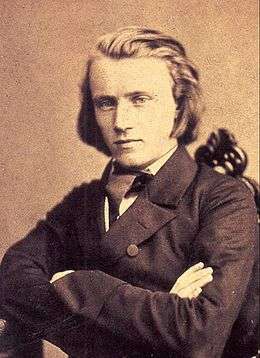Piano Quartet No. 2 (Brahms)
| Piano Quartet in A major | |
|---|---|
| No. 2 | |
| Chamber music by Johannes Brahms | |
 The composer in 1853 | |
| Catalogue | Op. 26 |
| Composed | 1861 |
| Performed | 1863 |
| Duration | 50 minutes |
| Movements | four |
| Scoring |
|
The Piano Quartet No. 2 in A major, Op. 26, by Johannes Brahms is scored for piano, violin, viola and cello. It was completed in 1861[1] and received its premiere in November 1863 by the Hellmesberger Quartet with the composer playing the piano part.[2] It has been especially noted for drawing influence from composer Franz Schubert.[3][1] Lasting approximately 50 minutes, this quartet is the longest of Brahms's chamber works to perform.
Structure
The quartet is in four movements:
Analysis
First movement
The first movement is in sonata form.
Second movement
The second movement is in rondo form.
Third movement
The third movement is a scherzo and trio in compound ternary form, where both the scherzo and the trio are in sonata form.
Fourth movement
The fourth movement is in sonata-rondo form.
References
- 1 2 "Johannes Brahms – Piano Quartet No.2 in A, Op.26". Classical Archives. Retrieved 2012-08-19.
- ↑ "Brahms: Piano Quartets –CD – CDA67471/2 – Johannes Brahms (1833–1897)". Hyperion Records. Retrieved 2012-08-19.
- ↑ LA Phil (2012-05-14). "Piano Quartet No. 2 in A major, Op. 26". LA Phil. Retrieved 2012-08-19.
External links
- Piano Quartet No. 2: Scores at the International Music Score Library Project (IMSLP)
This article is issued from
Wikipedia.
The text is licensed under Creative Commons - Attribution - Sharealike.
Additional terms may apply for the media files.